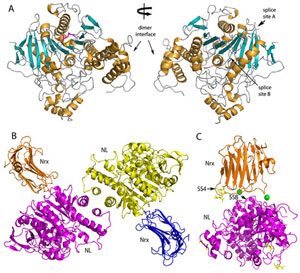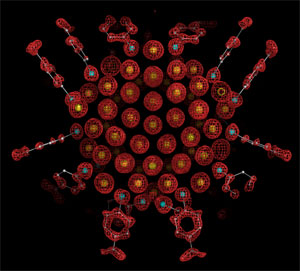

Contents of this Issue:
1. Science Highlight —
Another Step Toward Understanding Autism
(contacts: D. Arac, E. Özkan, P. Strop, E. Newell and A.T. Brunger,
Stanford University; A.A. Boucard and T. Südhof, University of Texas Southwestern Medical Center)
 | |
| Structures of Neuroligin-1 and the Neuroligin-1/Neurexin-1 b complex. [larger image] |
To learn more about this research see the full scientific highlight at:
http://www-ssrl.slac.stanford.edu/research/highlights_archive/neuroligin_hires.html
2. Science Highlight —
Structure of a Coated Gold Nanoparticle
(contacts: P.D. Jadzinsky, G. Calero, C.J. Ackerson, D.A. Bushnell and
R.D. Kornberg, Stanford University)
 | |
| X-ray crystal structure determination of Au102(p-MBA)44 nanoparticle. [larger image] |
To learn more about this research see the full scientific highlight at:
http://www-ssrl.slac.stanford.edu/research/highlights_archive/goldnano.html
3.
Holiday Greetings from the Director
 | |
|
|
Since SSRL began user operations in 1974, users have reported >8,000 scientific
publications based on research conducted at SSRL. In the last three years
alone, users published >1,100 papers including >95 student theses (reported to
date). If you have not responded to my recent request, I encourage you to
inform us of your SSRL-related publications, awards, and invited lectures
covering 2005-2007. This information is needed for a key program review of SSRL
by the DOE Office of Basic Energy Sciences which will be held in January. The
current lists of publications that have been reported to SSRL to date can be
found at
http://www-ssrl.slac.stanford.edu/pubs/. Please send these to Lisa
Dunn, lisa@ssrl.slac.stanford.edu, or use the web form at http://smb.slac.stanford.edu/forms/reporting/form_publication.shtml.
Thank you for your support.
The first joint SSRL and Linac Coherent Light Source (LCLS) Users' Meeting was
a wonderful success. Approximately 320 individuals participated in various
activities scheduled over the six-day event which began with a special
symposium on the future of x-ray science, September 28-29; this was followed on
September 30 with a joint SSRL/ALS workshop on synchrotron radiation
techniques. The main Users' Meeting, on October 1-2, featured presentations on
recent developments and new opportunities in structural biology, material and
environmental science, ultrafast science and LCLS instrumentation. On October
2, the keynote presentation was given by Nobel Laureate Professor Roger
Kornberg, who utilized SSRL's crystallography beam lines for his experiments on
RNA polymerase. The event concluded on October 3, 2007, with four concurrent
workshops: Imaging and X-ray Microscopy; Microfocusing; Scientific
Opportunities for Studying Laser Excited Dynamics at the LCLS; and XANES
Spectroscopy.
http://www-conf.slac.stanford.edu/ssrl-lcls/2007/default.htm
As part of the meeting tradition, several awards for outstanding scientific and technical achievement in synchrotron radiation-based science were presented, including prizes for Outstanding Student Scientific Posters: Brittany Nelson-Cheeseman (UC Berkeley), Origin of Anomalous Magnetic Behavior in NiMn2O4 Thin Films; Stephen Kelly (Stanford), The Effect of Cycling on Microstructure and Reaction Kinetics in Mg/MgH2; David Singer (Stanford), Using Synchrotron Radiation X-ray Techniques to Examine Uranium Speciation as a Function of Depth in Contaminated Hanford Sediments; and Samuel Wilson (Stanford), XAS Pre-edge and EXAFS Spectroscopy Reveals Mechanistic Differences between Tyrosine Hydroxylase and Other Pterin Dependent Hydroxylases. The William Spicer Young Investigator Award was presented to Hugh Harris, a lecturer at the School of Chemistry and Physics, University of Adelaide, Australia. Jessica Vey, a graduate student at MIT, received the Melvin Klein Professional Development Award. And, Cathy Knotts, Manager of SSRL User Research Administration received the Farrel Lytle Award.
I want to thank everyone who provided feedback and suggestions to us through the 2007 users' survey, the end-of-run surveys, and especially those individuals who serve on SSRL's advisory committees - the SSRL Scientific Advisory Committee (SAC), Proposal Review Panel (PRP), the SMB Advisory Committee (SMBAC) and the SSRL Users' Organization Executive Committee. Guidance from these groups is extremely important to help us plan and move forward in the wisest and most effective ways. We continue to be grateful to our funding agencies - the Department of Energy's Office of Basic Energy Sciences for providing the core operations funding and support for materials research and the DOE Office of Biological and Environmental Research and the National Institutes of Health NIGMS and NCRR Programs for support of the structural biology program. Without their effective support, we would not be able to push the scientific forefront and effectively serve our diverse and growing user community. I urge you to continue to let us know your opinions and ideas - it helps us to serve you better, to improve our operations and to plan for our future.
In closing, on behalf of SSRL and its staff, let me extend our very best wishes to all of you for this holiday season and for 2008!
—Jo Stöhr, SSRL Director
4.
Photon Science Faculty Receives Honors
(contact: C. Knotts, knotts@slac.stanford.edu)
Christopher E. D. Chidsey, Associate Professor of the Department of Photon Science and of the Department of Chemistry, has been elected Fellow of the American Association for the Advancement of Science (AAAS) for his distinguished contributions to understanding molecular electronics and its applications to energy efficiency, and for his commitment to improving teaching and learning. Election as a fellow is an honor bestowed upon AAAS members by their peers.
Many other members of our Photon Science faculty and user community have received awards and honors over the past few years. We greatly appreciate the input that we have received in response to our recent requests for information so far. If there are still more SSRL-related awards to be reported, and you have not yet done so, please contact us.
5.
Shipping and Receiving to Remain Open During Shutdown
—SLAC
Today article by Kelen Tuttle
Do you have an important package coming in over the next two weeks? Never fear! Shipping and Receiving will remain open during the shutdown, albeit with limited hours. Shipping and Receiving will be staffed between 8:00 a.m. and 12:00 p.m. on December 26, 27 and 28 as well as January 2. During this time packages may be picked up, but will not be delivered. Regular hours and operations will resume on Thursday, January 3.
__________________________________________________________________________
SSRL Headlines is published electronically monthly to inform SSRL users, sponsors and other interested people about happenings at SSRL. SSRL is a national synchrotron user facility operated by Stanford University for the U.S. Department of Energy Office of Basic Energy Sciences. Additional support for the structural biology program is provided by the DOE Office of Biological and Environmental Research, the NIH National Center for Research Resources and the NIH Institute for General Medical Sciences. Additional information about SSRL and its operation and schedules is available from the SSRL WWW site.
__________________________________________________________________________
To leave the SSRL-HEADLINES distribution, send email as shown below:
To: LISTSERV@SSRL.SLAC.STANFORD.EDU Subject: (blank, or anything you like)
The message body should read
SIGNOFF SSRL-HEADLINES
That's all it takes. (If we have an old email address for you that is forwarded to your current address, the system may not recognize who should be unsubscribed. In that case please write to ssrl-headlines-request@ssrl.slac.stanford.edu and we'll try to figure out who you are so that you can be unsubscribed.)
If a colleague would like to subscribe to the list, he or she should send To: LISTSERV@SSRL.SLAC.STANFORD.EDU and use the message body
SUBSCRIBE SSRL-HEADLINES
|
SSRL Welcome
Page | Research
Highlights | Beam Lines | Accel
Physics
User Admin | News & Events | Safety Office |